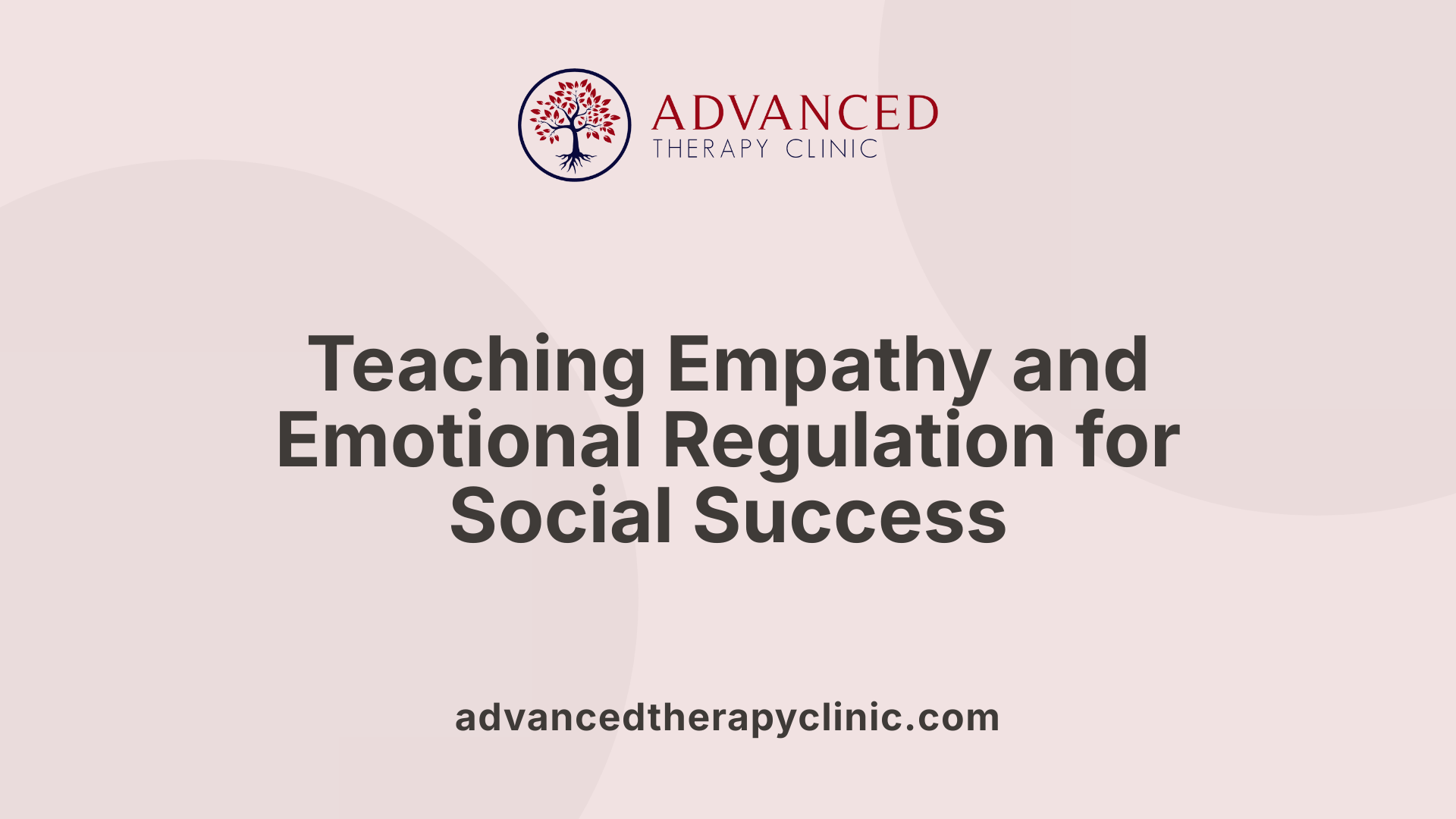The Role of ABA Therapy in Building Emotional Awareness


Understanding the Intersection of ABA Therapy and Emotional Awareness
Emotional development is a foundational aspect of social, academic, and mental health for children, particularly those on the autism spectrum. Applied Behavior Analysis (ABA) therapy has emerged as a leading intervention, emphasizing structured, individualized strategies to foster emotional recognition, regulation, and empathy. While highly supported by scientific research, ABA’s role in emotional development also sparks discussion regarding its methodologies and long-term effects—a debate that underscores the importance of adaptive, ethical practice. This article explores the multifaceted role of ABA therapy in building emotional awareness, highlighting techniques, benefits, and the evolving perspectives surrounding this intervention.
Techniques Used in ABA Therapy to Build Emotional Skills
What techniques are used in ABA therapy to build emotional skills?
Applied Behavior Analysis (ABA) employs a variety of evidence-based techniques to help children develop essential emotional skills. These methods focus on teaching children how to recognize, understand, and regulate their emotions while improving their social interactions.
One fundamental approach is social skills training, which involves teaching children appropriate ways to behave in social situations. This can include turn-taking, sharing, and understanding social cues. Role-playing is a common technique where children practice real-life scenarios in a safe environment, helping them learn appropriate emotional responses and develop empathy.
Using social stories is another effective method. These are short narratives that depict specific social situations and illustrate how to respond emotionally and socially. Social stories help children understand expectations and learn appropriate ways to express feelings.
Emotion recognition exercises are crucial for building emotional awareness. These activities help children identify, label, and interpret emotions in themselves and others, often through facial expression matching, emotion identification games, and perspective-taking activities.
Positive reinforcement plays a vital role in ABA for encouraging desired behaviors. When children correctly recognize or regulate their emotions, they are rewarded with praise or preferred incentives. This reinforcement motivates continued practice and helps establish healthy emotional habits.
Modeling behaviors is another key technique, where therapists or caregivers demonstrate emotional responses and expressions for children to observe and imitate. This method provides clear examples of appropriate emotional expression.
Functional communication training (FCT) is used to replace problematic behaviors with more appropriate communication strategies to express emotions. For example, teaching a child to use words or gestures instead of aggressive actions when upset.
Self-monitoring and relaxation techniques are incorporated to help children become aware of their emotional states and learn calming strategies. These may include deep breathing exercises, using visual aids like feelings charts, or occupying a quiet space to de-escalate emotional distress.
Overall, ABA therapy is tailored to each child's unique needs, combining these techniques into structured interventions. This individualized approach supports children in learning how to recognize, express, and manage emotions effectively, which in turn enhances their social interactions and emotional resilience.
Supporting Emotional Understanding and Growth with ABA

How does ABA therapy support emotional understanding and growth?
ABA, or Applied Behavior Analysis, is a widely respected approach that helps children with autism develop essential emotional skills. By employing evidence-based techniques such as social stories, visual emotion charts, and modeling, ABA teaches children to recognize, understand, and express their feelings more effectively.
Structured activities like role-playing and emotion recognition tools are core components of ABA. These methods allow children to practice identifying emotions in various contexts, improving their emotional literacy. For example, using social stories to simulate real-life situations helps children understand how to respond appropriately to different emotional cues.
Positive reinforcement plays a crucial role in building emotional resilience. By rewarding desirable behaviors—like calming down or expressing feelings appropriately—children learn to regulate their emotions better. This reinforcement encourages repeated use of emotional skills, fostering independence and confident social interactions.
ABA also emphasizes identifying triggers that may cause stress or emotional outbursts. Recognizing these triggers enables the development of effective coping strategies, such as using relaxation techniques or engaging in calming activities. These strategies are often taught alongside mindfulness exercises and relaxation practices, further enhancing emotional self-awareness.
Incorporating role-play scenarios allows children to practice navigating complex emotional situations safely. This not only boosts their understanding of emotions but also builds their confidence in handling social challenges.
By combining visual tools, modeling, reinforcement, and coping strategies, ABA creates a comprehensive environment for emotional growth. The overall goal is to support children in gaining lasting emotional skills. These skills facilitate better self-regulation, resilience, and social competence, contributing to happier, more independent lives.
Research indicates that such structured, personalized interventions lead to meaningful improvements in emotional understanding and behavioral outcomes for children with autism. As these skills develop, children are better equipped to participate fully in social activities, school, and community.
In summary, ABA therapy supports emotional growth through a combination of structured practices, visual aids, modeling positive behaviors, role-playing, and reinforcement strategies. This holistic approach helps children enhance their emotional awareness, self-regulation, and capacity for social connection, fostering a foundation for lifelong emotional well-being.
The Effectiveness of ABA in Developing Emotional Awareness

What are the benefits and effectiveness of ABA therapy in fostering emotional awareness?
Applied Behavior Analysis (ABA) is recognized as a highly effective approach in enhancing emotional awareness among children with autism. Its focus on teaching emotional recognition, self-regulation, and social skills makes it a comprehensive tool for emotional development.
ABA uses systematic methods like reinforcement, modeling, and individualized teaching strategies to help children understand and interpret their own emotions, as well as the feelings of others. Through consistent practice and positive reinforcement, children learn to recognize emotional cues such as facial expressions, body language, and tone of voice.
An important aspect of ABA is its data-driven nature, which allows therapists to monitor continuous progress. This ongoing tracking ensures that interventions are tailored to meet each child's evolving needs and that emotional skills develop steadily over time.
Research supports the effectiveness of ABA in boosting empathy and social interaction, both crucial components of emotional awareness. For instance, studies show improvements in children’s ability to identify emotions and respond appropriately in social settings.
ABA programs often incorporate play-based and naturalistic techniques, making learning engaging and relevant. Techniques such as role-playing, social stories, and emotion identification games are commonly used, further reinforcing understanding and anticipation of emotional responses.
Moreover, early intensive ABA intervention has been linked with better outcomes in emotional and social functioning, especially in children at risk of not becoming verbal.
The overall goal of ABA therapy is to build skills that promote independence and improve quality of life. By enhancing emotional awareness alongside communication and social skills, ABA helps children participate more fully in society.
Many systematic reviews and scientific studies support ABA's role in emotional development. These studies indicate that with consistent application, children show marked improvements in recognizing emotions, managing their feelings, and developing empathy.
In conclusion, ABA therapy offers a structured, adaptable, and scientifically supported approach to fostering emotional awareness. Its focus on positive reinforcement and individualized goals ensures that children gain crucial emotional skills that contribute to their social integration and overall well-being.
Play-Based Learning and Social Skills Training in ABA

How are strategies like play-based learning and social skill training used in ABA to enhance emotional understanding?
Play-based learning and social skills training are essential parts of Applied Behavior Analysis (ABA) therapy, helping children develop emotional skills through engaging and natural activities.
In play-based learning, children explore emotions by engaging in imaginative play, which allows them to express feelings and develop empathy in a safe, supportive environment. For example, children might role-play different scenarios, practicing how to recognize and respond to various emotions such as happiness, anger, or sadness.
Role-playing is a particularly effective technique used in ABA to teach perspective-taking and emotional recognition. Children act out social situations, learning to identify social cues, facial expressions, and emotions. This not only helps in understanding others' feelings but also builds emotional regulation skills.
Visual aids like emotion charts and social stories are incorporated to make emotional concepts more concrete. Feelings charts—like the
The Impact of ABA’s Social-Emotional Curriculum
How does ABA therapy's social-emotional curriculum enhance emotional awareness and regulation?
ABA therapy's social-emotional curriculum plays a significant role in helping children with autism develop vital emotional skills. It systematically teaches foundational abilities like recognizing, understanding, and managing emotions, which are essential for effective social interaction and mental health.
One core method used is the incorporation of visual supports. These include pictures, cue cards, and visual cues such as color-coded systems (like stoplight charts) that help children identify and label their emotional states. Visual supports make abstract concepts more concrete, easing understanding and recall.
Modeling behaviors is another essential strategy. Therapists and parents demonstrate appropriate emotional expressions and response strategies, guiding children to imitate and practice these behaviors themselves. Labeling emotions involves explicitly naming feelings during interactions, teaching children to recognize and articulate their own and others' emotions.
Discrete Trial Teaching (DTT) and Behavior Skills Training (BST) are structured methods used within the curriculum. These involve repeated practice, immediate feedback, and reinforcement to help children reliably identify and regulate their emotions. For example, a child might be prompted to select the correct emotional label or demonstrate a calming technique.
Promoting generalization of these skills across different settings and with various people is crucial. This is achieved by practicing emotional regulation in diverse environments, encouraging children to apply learned strategies during school, at home, or in social settings.
The curriculum emphasizes positive reinforcement, rewarding successful recognition and management of emotions to motivate continued effort. Reflective feedback from therapists helps strengthen learning and self-awareness.
Overall, ABA’s social-emotional approach offers evidence-based tools that foster greater emotional insight, self-control, and social competence. By building these skills systematically, children with ASD are better equipped to navigate social situations, reduce problematic behaviors, and experience more adaptive emotional responses.
The Role of ABA in Developing Emotional Awareness
What is the role of ABA therapy in developing emotional awareness in children with autism?
Applied Behavior Analysis (ABA) is a scientifically supported therapy that significantly contributes to building emotional awareness in children with autism. Its primary focus is on teaching children to recognize, understand, and appropriately respond to both their own emotions and those of others, which is vital for effective social functioning.
ABA therapy employs a variety of targeted strategies tailored to each child's needs. For example, emotion labeling involves teaching children to identify and name different feelings using visual aids like feelings charts or social stories. Modeling, another technique, demonstrates appropriate emotional responses through play-based activities, helping children imitate and internalize these behaviors.
Social stories and role-playing scenarios are also incorporated to simulate real-life situations, enabling children to practice recognizing social cues and understanding emotional responses.
Reinforcement techniques, such as praise or preferred activities, reward successful emotional recognition and regulation, promoting confidence and motivation. Consistent routines and environments, a hallmark of ABA, help children apply these skills across various settings, supporting generalization.
Furthermore, individualized ABA plans focus on strengthening foundational social and communication skills that are essential for emotional understanding, such as eye contact and turn-taking.
This comprehensive approach ensures that children learn not only to identify emotions but also to respond appropriately, forming the basis for meaningful social interactions.
Research consistently shows that ABA's structured, data-driven methods are effective in improving emotional recognition and regulation. These improvements can lead to better social relationships, reduced behavioral issues stemming from emotional dysregulation, and increased independence.
Overall, ABA offers a robust, evidence-based framework that enhances emotional development, helping children with autism participate more fully and joyfully in their communities.
The Significance of Teaching Empathy, Self-Regulation, and Emotional Recognition

Why is ABA therapy considered important for teaching empathy, self-regulation, and emotional recognition?
ABA therapy plays a vital role in supporting children with autism to develop crucial social and emotional skills. It is an individualized, evidence-based approach that tailors interventions to each child's unique needs, goals, and interests. By focusing on specific behaviors and skills, ABA helps children understand and identify their own emotions, as well as recognize emotions in others.
One of ABA's strengths is its use of positive reinforcement, which encourages children to practice desired behaviors repeatedly. For example, rewarding a child for correctly identifying a facial expression or demonstrating empathy during social interactions promotes skill acquisition and confidence.
Structured teaching strategies, such as emotion identification games, role-playing, and social stories, are integrated into ABA programs. These activities help children expand their emotional vocabulary and learn appropriate responses to various emotional cues. As children become more adept at recognizing emotions, they are better able to manage their reactions and develop emotional regulation skills.
Teaching emotional regulation techniques—like deep breathing exercises, counting, or using visual supports—are common components of ABA therapy. These techniques aid children in gaining self-control during stressful or challenging situations, fostering resilience and reducing problematic behaviors.
Furthermore, ABA emphasizes enhancing social interaction skills, which are fundamental for meaningful relationships. Through social skills training, children learn to interpret social cues, engage in conversations, and show empathy towards peers.
Overall, ABA contributes significantly to building emotional competence and improving social functioning. This comprehensive approach equips children with the tools necessary for navigating daily life, forming relationships, and participating successfully in their communities.
Additional insights from research reinforce that early, intensive ABA interventions can notably improve outcomes for children at risk of not developing verbal skills and social independence.
In summary, ABA's structured, positive, and individualized strategies are essential for teaching empathy, self-regulation, and emotional recognition—fundamental skills that influence a child's overall development and well-being.
Controversies and Criticisms of ABA in Emotional Development

What are the criticisms surrounding ABA therapy's impact on emotional development?
Applied Behavior Analysis (ABA) has a long history as a prominent intervention for children with autism, but it is not without controversy. Critics, especially from autism rights and neurodiversity communities, raise concerns about how traditional ABA practices have historically impacted emotional development.
One primary concern relates to the historical use of punitive measures. In earlier implementations, some ABA programs employed aversives or punishment strategies to modify behavior. Although modern ABA has shifted away from such methods, critics argue that residual practices have sometimes caused emotional harm. They suggest that these approaches might have suppressed natural behaviors, leading to emotional distress, anxiety, or trauma.
Many advocates also point out that ABA often focuses heavily on external behavior correction without sufficiently addressing internal emotional states. This emphasis on observable actions can overlook the child’s emotional needs or personal identity. As a result, some children may learn to mask their true feelings or adopt coping mechanisms that hide their internal emotional experiences.
This phenomenon, known as masking, can lead to emotional exhaustion and burnout. When children feel compelled to hide their authentic selves to meet external expectations, it can cause frustration, stress, and reduced self-esteem over time.
Furthermore, critics are concerned that the focus on behavior modification may inadvertently prioritize conforming to neurotypical standards over supporting the child's self-expression and individual interests. This may have long-term effects, such as diminished emotional resilience or difficulties in genuine self-acceptance.
Research linking ABA to Post-Traumatic Stress Disorder (PTSD)-like symptoms has added to these concerns. Although some of these studies face criticism regarding their methodology, they underscore the importance of ethically delivered ABA and the potential for emotional harm if not carefully managed.
While many recent ABA practices aim to be respectful and individualized, these criticisms highlight the importance of ongoing evaluation and ethical standards. Ensuring that therapy respects each child's emotional well-being and personal identity is crucial.
In essence, these debates emphasize that ABA, when used rigidly or insensitively, might hinder genuine emotional growth and well-being. It's essential that ABA remains flexible, personalized, and integrated with approaches that promote emotional understanding, self-expression, and respect for neurodiversity.
Building Emotional Foundations Through Adaptive Practice
The evolution of ABA therapy reflects a broader understanding of emotional development and ethical considerations. While its techniques and strategies have been proven effective in fostering emotional awareness, empathy, and regulation, ongoing dialogue about its implementation underscores the need for adaptive, respectful approaches. When delivered ethically and tailored to individual needs, ABA remains a powerful tool supporting children with autism in gaining emotional competence that enhances their social integration and overall well-being. Recognizing both its strengths and limitations encourages continuous refinement to ensure that emotional development remains a central goal of autism interventions.
References
- Importance of Emotional Development Explained - AutismCOE
- Teaching Empathy and Emotions Through Play - GentleCare Therapy
- The Controversy Around ABA - Child Mind Institute
- Play Therapy For Autism: What Parents Need to Know - Blue ABA
- Emotion Regulation: Concepts & Practice in Autism Spectrum Disorder
- Applied Behavior Analysis (ABA) | Autism Speaks
- What is Emotional Regulation? Breaking Down the Basics for ABA ...
- The effectiveness of applied behavior analysis program training on ...
- Applied Behavior Analysis (ABA) | Autism Speaks
- How Does ABA Help with Emotions in Autism?
Recent articles

The Benefits of ABA Therapy for Sibling Relationships and Family Bonds
Strengthening Family Ties Through Applied Behavior Analysis

How Speech Therapy Assists with Improving Verbal and Nonverbal Communication
Unlocking Communication Potential: The Role of Speech Therapy

Supporting Autism During Transitions
Strategies and Therapies to Navigate Transitions for Children with Autism

Low-Functioning Autism
Understanding Support and Therapies for Autism Spectrum Disorder Level 3

How Speech Devices Enhance Communication for Nonverbal Children
Transforming Communication: The Role of Speech Devices for Nonverbal Children

TEACCH Method For Autism
Comprehensive Therapeutic Approaches for Autism Spectrum Disorder


